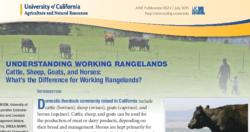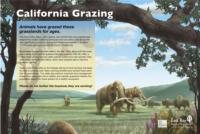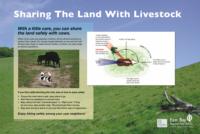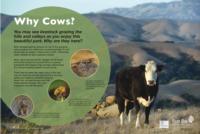Grazing on Public Lands
On this page:
- Overview: Why grazing is important
- Fact Sheets
- Sharing Open Space Videos
- Interpretive Signs
Overview
In California 30% of public land is rangeland, covering over 32 million acres (Fire and Resource Assessment Program 2010). As populations and demand for resources increase on an otherwise finite land base, interactions and conflicts inevitably arise.
While the primary use of rangelands for well over a century has been livestock grazing to produce food and fiber, an elevated interest in and demand for recreational areas has increasingly brought livestock-recreation interactions to forefront.
Perceived and real conflict between recreationist and grazing has led to the eliminating grazing from some public lands, reducing public land manager’s ability to manage vegetation and protect conservation values (Barry 2014).
Conflicts can be minimized and the benefits of these concurrent uses maximized with appropriate policies, management, and oftentimes, creativity on the part of both livestock managers and recreationists.
Sharing Open Space Videos
Sharing open spaces with livestock
When you have a dog
A year in the life of a cow
A Year in the Life of a Cow: explains the important role of animal feeding operations in supporting rangeland livestock production.
Bay Area Ranching Heritage: A Continuing Legacy, describes the long heritage of ranching in California, focusing on the Bay Area, and the importance of public lands grazing
Benefits of Grazing - Livestock Grazing: A Conservation Tool on California's Annual Grasslands, explains and provides research-based information about the role of livestock grazing in managing open space.
Cattle, Sheep, Goats, and Horses: What’s the Difference for Working Rangelands? How different livestock affects land and vegetation in several interrelated ways.
Cows Need Water, Too: Water Sources, Wetlands, and Riparian Areas how cattle grazing around vernal pools also supports habitat quality for vernal pool fauna such as fairy shrimp and tadpole shrimp.
Grazing Systems Management improved forage productivity, soil health and biodiversity and the use of grazing systems.
Ranching Infrastructure: Tools for Healthy Grasslands, Livestock, and Ranchers about working livestock equipment and facilities.
Sharing Open Space: What to Expect from Grazing Livestock about cattle behavior.
Conflicts can be minimized and the benefits of these concurrent uses maximized with appropriate policies, management, and oftentimes, creativity and leniency (i.e., giving the benefit of the doubt) on the part of both livestock managers and recreationists. Novel approaches to public education and collaborative land management where livestock graze and recreationists roam are critical to reducing negative livestock-recreation encounters and enhancing the many benefits that these land uses and ecosystem services provide (Brunson and Steel 1996, Resnik et al. 2006, Brunson and Huntsinger 2008).
We worked with the Sonoma County Regional Parks to develop signage that would help their park visitors to Taylor Mountain understand why livestock are grazing in parks, and how to avoid negative interactions with them. View Signage
The UCCE advisors developed several educational publication and park signage to educate users and cattle producers on maintaining proper livestock grazing and rancher stewardship on California’s rangelands with public access and recreation through public education and outreach. These educational tools will:
1) Reduce negative interactions between livestock and park users.
2) Increase park users comfort while recreating with livestock grazing.
3) Provide a tool for ranchers to help explain livestock behavior to park users.
4) Maintain public support for grazing as a management tool on public lands with recreation.





